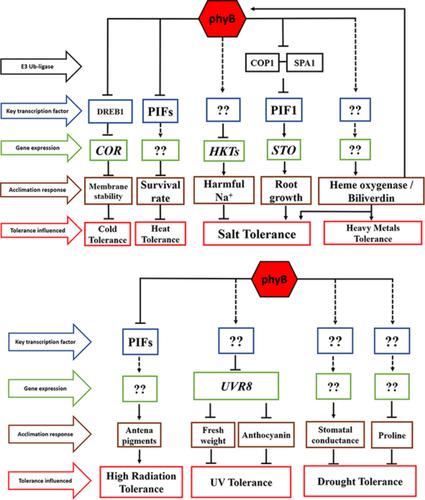当前位置:
X-MOL 学术
›
Ann. Appl. Biol.
›
论文详情
Our official English website, www.x-mol.net, welcomes your
feedback! (Note: you will need to create a separate account there.)
Phytochrome type B family: The abiotic stress responses signaller in plants
Annals of Applied Biology ( IF 2.2 ) Pub Date : 2020-10-14 , DOI: 10.1111/aab.12655 Carlos Alberto Silva Junior 1 , Victor D'Amico‐Damião 1 , Rogério Falleiros Carvalho 1
Annals of Applied Biology ( IF 2.2 ) Pub Date : 2020-10-14 , DOI: 10.1111/aab.12655 Carlos Alberto Silva Junior 1 , Victor D'Amico‐Damião 1 , Rogério Falleiros Carvalho 1
Affiliation

|
Photoreceptors are primarily known as key photomorphogenic modulators of various physiological events during plant development. Although there are different groups of photoreceptors, the phytochrome B (phyB) family mediates developmental responses in a wide range of plant species, from seed germination to flowering. In addition, these molecules also regulate abiotic stress acclimation responses, such as salinity, drought, low/high temperature, high light and heavy metals. The signalling pathways mediated by phyB could enhance plant resistance to environmental stresses, as phyB photoreceptors reduce leaf transpiration, increase the antioxidant system, enhance protective pigments and increase the expression of genes related to plant stress acclimation. Thus, the elucidation of positive or negative roles for phyB in these stress tolerance characteristics would provide essential knowledge for genetic engineering, improving plant growth and development in critical environments. In this review, we cover the main findings on how the phyB family works to modulate abiotic stress by discussing biochemical and molecular aspects of the underlying mechanisms operated by these photoreceptors.
中文翻译:

B型植物色素:植物中的非生物胁迫响应信号
光感受器主要被称为植物发育过程中各种生理事件的关键光形态发生调节剂。尽管存在不同的感光体组,但植物色素B(phyB)家族介导了从种子发芽到开花的多种植物物种的发育响应。另外,这些分子还调节非生物胁迫适应性反应,例如盐度,干旱,低温/高温,高轻金属和重金属。phyB介导的信号转导途径可增强植物对环境胁迫的抗性,因为phyB感光细胞减少了叶片的蒸腾作用,增加了抗氧化系统,增强了保护性色素,并增加了与植物逆境适应相关的基因的表达。因此,阐明phyB在这些胁迫耐性特征中的正负作用将为基因工程,改善关键环境中植物的生长和发育提供必要的知识。在这篇综述中,我们讨论了phyB家族如何调节非生物胁迫的主要发现,方法是讨论这些光感受器发挥作用的潜在机制的生化和分子方面。
更新日期:2020-10-14
中文翻译:

B型植物色素:植物中的非生物胁迫响应信号
光感受器主要被称为植物发育过程中各种生理事件的关键光形态发生调节剂。尽管存在不同的感光体组,但植物色素B(phyB)家族介导了从种子发芽到开花的多种植物物种的发育响应。另外,这些分子还调节非生物胁迫适应性反应,例如盐度,干旱,低温/高温,高轻金属和重金属。phyB介导的信号转导途径可增强植物对环境胁迫的抗性,因为phyB感光细胞减少了叶片的蒸腾作用,增加了抗氧化系统,增强了保护性色素,并增加了与植物逆境适应相关的基因的表达。因此,阐明phyB在这些胁迫耐性特征中的正负作用将为基因工程,改善关键环境中植物的生长和发育提供必要的知识。在这篇综述中,我们讨论了phyB家族如何调节非生物胁迫的主要发现,方法是讨论这些光感受器发挥作用的潜在机制的生化和分子方面。











































 京公网安备 11010802027423号
京公网安备 11010802027423号